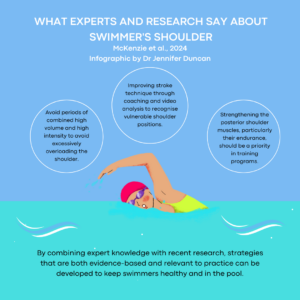This blog is based on a recent study, published in BJSM (1).
Why is this study important?
Most swimmers will injure their shoulder at some point throughout their career. The term “swimmer’s shoulder”, coined in the 1970’s, remains relevant today due to ongoing challenges in preventing and effectively rehabilitating a sore or injured shoulder. Swimmer’s shoulder usually results from high swimming volume – thousands of strokes per week, for years on-end. However, some factors may increase a swimmer’s risk of developing shoulder pain.
Although a lot of research has explored shoulder injury risk factors in swimmers, the complex nature of these injuries and the controlled conditions under which research is done, means findings may not be directly relevant to all swimmers. Therefore, as well as reviewing what research shows about swimmer’s shoulder, we thought it was important to hear what expert practitioners, those who work directly with swimmers, have to say about managing shoulder injuries.
How did the study go about this?
We used “concept mapping” to gather insights from 27 swimming experts, including: elite swimmers, coaches, support staff, and researchers. First, we asked the experts to brainstorm all the factors they thought might contribute to shoulder injuries in swimmers. Next, we asked the experts to rate how important and modifiable (changeable) each factor was.
Our research team then compared these expert opinions to the findings of a systematic review we recently conducted on risk factors for shoulder injury in swimmers. This comparison allowed us to identify where expert opinions and scientific evidence aligned, as well as areas they differed (i.e., an evidence-practice gap).
What did the study find?
Our study revealed a substantial gap between what experts think and the available scientific evidence regarding swimmer’s shoulder. Here are some key findings:
- Practice directing Evidence: Experts identified 22 factors they thought were highly important contributors to shoulder injuries but haven’t been studied by researchers. This highlights a difference between what practitioner’s think is important and where research efforts have been focused.
- Practice ≠ Evidence: Experts rated six factors as highly important, despite scientific evidence suggesting they aren’t linked to shoulder injuries. This disconnection suggests that some current shoulder injury prevention strategies might target the wrong factors. Alternatively, it suggests researchers may need new methods to identify and monitor shoulder injury risk factors, particularly those relating to maximal strength and range of motion (shoulder flexibility).
- Practice & Evidence: Three factors stood out as both highly important to experts and supported by research:
- Inconsistent training load: Sudden changes to total training volume (more/longer sessions each week) or intensity (more sprinting than usual).
- Poor stroke technique: Faults in a swimmer’s stroke mechanics.
- Low posterior shoulder strength-endurance: Weakness in the muscles that are thought to stabilize the back of the shoulder throughout a long session.
What are the key take-home points?
There is a need for improved communication and collaboration between swimming researchers and expert practitioners to effectively prevent swimmer’s shoulder. Future research should focus on the factors/issues that experts think are most pressing.
Based on our findings, here are some practical takeaways:
- Swimmers and coaches should pay particular attention to managing training load, gradually increasing volume and intensity. Avoid periods of combined high volume and high intensity to avoid excessively overloading the shoulder.
- Improving stroke technique through coaching and video analysis to recognise vulnerable shoulder positions.
- Strengthening the posterior shoulder muscles, particularly their endurance, should be a priority in training programs.
By combining expert knowledge with recent research, strategies that are both evidence-based and relevant to practice can be developed to keep swimmers healthy and in the pool.

Watch this video to learn more about this recent research.
References:
- McKenzie AK, Hams A, Headrick J, et al Identifying evidence-practice gaps for shoulder injury risk factors in competitive swimmers: uniting literature and expert opinionBritish Journal of Sports Medicine Published Online First: 05 August 2024. doi: 10.1136/bjsports-2023-108023
Authors and affiliations:
Alec McKenzie 1, 2, Andrea Hams 1,3, Jonathon Headrick 1, Alex Donaldson4, Joseph Coyne 5, 6, and Steven Duhig 1.
1 Griffith University, Gold Coast, Queensland, Australia.
2 Queensland Academy of Sport (SPIKE), Brisbane, Queensland, Australia.
3 Griffith Centre of Biomedical and Rehabilitation Engineering (GCORE), Griffith University, Gold Coast, Queensland, Australia.
4 Centre for Sport and Social Impact, LaTrobe University, Melbourne, Victoria, Australia.
5 Bond University, Robina, Queensland, Australia.
6 University of Southern Queensland, Toowoomba, Queensland, Australia.
Acknowledgments:
Special thanks to Swimming Australia and the Queensland Academy of Sport for providing the necessary funding and for disseminating our survey to relevant expert practitioners.